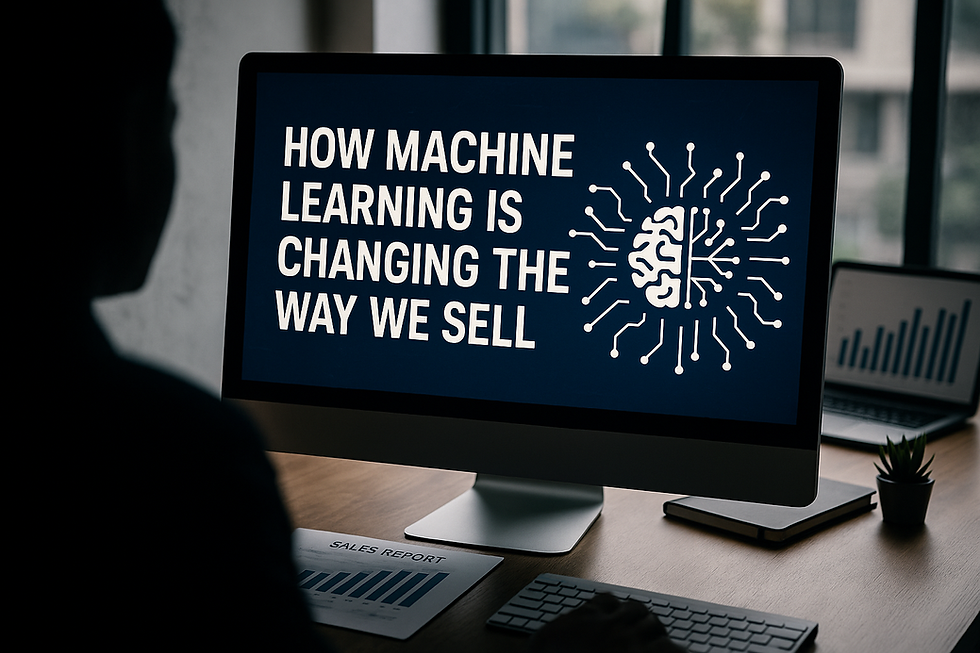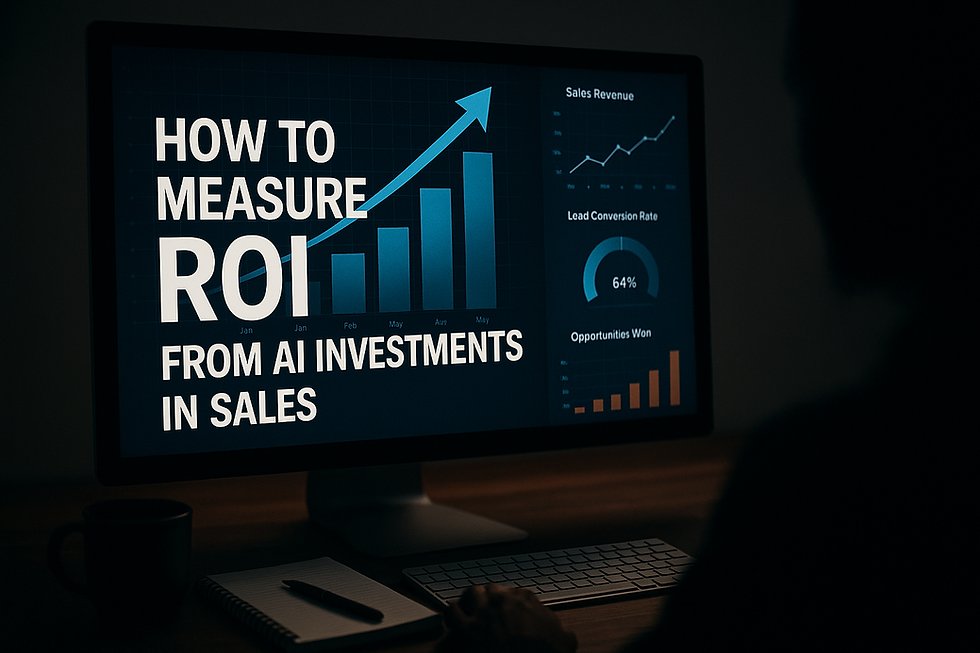Key Machine Learning Terms for Sales Professionals (Explained in Simple English)
- Muiz As-Siddeeqi

- 4 days ago
- 6 min read

Key Machine Learning Terms for Sales Professionals (Explained in Simple English)
You don’t need to be a data scientist to win in the new sales world.
But if you're still scratching your head when someone says “training data” or “overfitting,” then you’re leaving deals, dollars, and your competitive edge on the table.
And it’s not your fault.
We weren’t taught this stuff. Most blogs throw math at your face. Salespeople don’t want that. You want clarity, confidence, and real words—without feeling like you're back in high school algebra class.
So we sat down, sifted through thousands of pages of real reports, real sales implementations, real case studies from companies like Salesforce, HubSpot, IBM, Adobe, LinkedIn, Outreach, and more — and we wrote this.
Not just to simplify machine learning. But to build a guide that actually makes sense — a guide that explains the most important machine learning terms for sales professionals in plain, everyday English.
This isn’t a cheat sheet. This is a sales survival guide.
Let’s go through the real-world machine learning terms every sales pro must know today — in ultra-simple, ultra-clear English.
Bonus: Machine Learning in Sales: The Ultimate Guide to Transforming Revenue with Real-Time Intelligence
Let’s Be Real: Why This Matters Now (With Stats)
Before we dive into the terms — let’s talk about the why.
→ McKinsey reports that companies using AI in sales improve leads and appointments by 50%, reduce call time by 60%, and achieve cost reductions of 40-60%. [Source: McKinsey & Company, "AI in Sales," 2022]
→ Gartner found that by 2025, 75% of B2B sales organizations will augment traditional sales playbooks with AI-driven insights. [Gartner, Future of Sales 2025 Report]
→ In 2023, Outreach.io said their customers using ML-based forecasting had 35% more accurate pipeline predictions. [Outreach 2023 Customer Benchmark Study]
This isn’t optional anymore. Understanding the terms is step one.
1. Machine Learning (ML)
Let’s not overcomplicate it.
Machine Learning means computers learn patterns from data — without being explicitly programmed step by step.
In sales, it means:
Predicting who will convert
Recommending next best actions
Scoring leads based on past buyer behavior
Automating email personalization
Real-world example:Salesforce Einstein uses ML to recommend the best opportunities to focus on. It does this by analyzing past deals, behaviors, interactions — and “learning” what successful deals look like. [Source: Salesforce Einstein documentation]
2. Artificial Intelligence (AI)
Let’s be blunt: ML is just one part of AI.
AI is a broad term. Machine Learning is a subset of it.
In sales, AI includes:
Voice assistants (like Drift’s AI reps)
Chatbots
Natural Language Processing (NLP) that understands emails or customer intent
Image recognition (used in product sales or demos)
AI = umbrella.
ML = one tool under that umbrella.
3. Training Data
This is the heart of ML.
It's the real-world data you use to teach the algorithm.
For example:You feed the system with 1,000 past sales records (closed-won, closed-lost, deal sizes, call recordings, email opens, etc.).
This becomes the training data to help the system recognize patterns.
Why it matters:Bad training data = bad predictions.
In 2021, MIT Technology Review published a report showing that over 85% of AI project failures were due to poor or biased training data.
4. Test Data
Once your model is trained, how do you test if it works?
You use test data — examples the model hasn’t seen before.
This tells you if the model really learned patterns — or just memorized the training data.
Like a student who crammed the textbook but can’t solve real-world problems — that’s what happens if you skip good test data.
5. Features
In ML, features are the individual variables or data points you feed the model.
In sales, features can be:
Number of emails sent
Time since last contact
Deal size
Role of buyer
Industry
The more relevant and clean your features, the smarter your model.
Real example:
HubSpot’s AI Lead Scoring includes features like website visits, email opens, and CRM engagement to predict deal probability. [Source: HubSpot AI Docs]
6. Labels
If features are the input, labels are the output.
They tell the model: “This is what we’re trying to predict.”
In sales:
A label might be: “Deal Closed = Yes or No”
Or: “Lead converted = Yes or No”
The model learns to map features → labels.
Without labels, supervised learning doesn’t work.
7. Supervised Learning
This is the most common ML approach used in sales.
You give the model both:
Features (like email open rates, deal size, etc.)
Labels (like “Closed-Won” or “Lost”)
And the model learns to predict future outcomes.
Used in:
Lead scoring
Churn prediction
Conversion likelihood
8. Unsupervised Learning
Here, there are no labels.
The algorithm explores data and finds hidden patterns on its own.
In sales, this powers:
Customer segmentation (Who are your hidden buyer groups?)
Product recommendation engines
Behavior clustering
Real example:Adobe Sensei uses unsupervised learning to segment customers and personalize product suggestions based on behavioral patterns. [Adobe ML Platform Overview, 2023]
9. Overfitting
Imagine teaching a model so well that it memorizes your sales data perfectly — but fails on new leads.
That’s overfitting.
It performs well on known data but fails in the wild.
In 2020, a study by Google AI research found overfitting was the top cause of pipeline prediction inaccuracies across multiple enterprise CRM datasets. [Source: Google Research]
10. Underfitting
The opposite of overfitting.
It means the model didn’t learn enough.
It’s too simple to spot real patterns.
Like using only “number of emails sent” to predict deal success — not enough data or depth.
11. Natural Language Processing (NLP)
NLP helps machines understand human language.
It’s what powers:
Email sentiment analysis
AI writing suggestions
Smart follow-ups
Voice-to-text CRMs
Chatbots
Real stat:
Drift’s AI Assistant using NLP increased engagement by 35% in pilot B2B deployments across SaaS sectors. [Source: Drift Product Results, 2022]
12. Regression
This isn’t about math class.
Regression means predicting numeric values.
In sales:
Predicting deal size
Estimating revenue
Forecasting time to close
Used heavily in sales forecasting models.
13. Classification
This is about yes/no, true/false, A or B predictions.
Is this lead likely to convert?Is this email positive or negative?Is this buyer a decision-maker?
Regression = numbersClassification = categories
14. Model Accuracy / Precision / Recall
Every ML model needs performance metrics.
→ Accuracy: How often was the model right?
→ Precision: When the model said “yes,” how often was it correct?
→ Recall: How many real “yes” cases did it catch?
You want high precision and high recall — especially in lead scoring and opportunity prioritization.
15. Model Drift
Sales change. Markets change. Buyer behavior changes.
Model drift is when your ML model becomes less accurate over time because the world shifted.
Real case:
Outreach.io noticed model drift in their pipeline score algorithms post-COVID, as virtual meetings replaced traditional calls. They had to retrain models quarterly to stay accurate. [Source: Outreach ML Ops Team Blog, 2021]
16. Retraining
To fix model drift, you retrain the model with new data.
Retraining ensures your AI stays relevant.
Big teams often retrain models every 1-3 months. Some do it weekly.
17. Bias in Data
This is serious.
Bias happens when your training data reflects past human mistakes or gaps.
For example, if you’ve always favored large enterprise leads, your model may automatically deprioritize SMBs — even if they’re now converting better.
Real warning:The World Economic Forum listed “bias in AI models” as a top 10 ethical risk for enterprises in 2022. [Source: WEF AI Governance Report]
18. Confidence Score
Not all predictions are equal.
A model doesn’t just say “Yes” — it says:
“I’m 92% confident this lead will convert.”
This helps sales reps trust the output and act accordingly.
19. Confusion Matrix
No, it's not a sci-fi term.
It’s a table showing where your model got things right and wrong.
Sales ops teams use this to debug misclassified leads and improve targeting.
20. A/B Testing in ML
ML outputs still need human validation.
A/B testing helps compare:
AI-generated emails vs. manual ones
AI-predicted best time to contact vs. traditional timings
Example:Chorus.ai tested AI-recommended call times vs. rep-chosen slots. AI won with +23% call pick-up rate. [Source: Chorus Product Insights, 2021]
Bonus Terms Every Sales Pro Should Hear at Least Once
Cold Start Problem: No data = no predictions.
Black Box Models: Complex models with decisions that are hard to explain.
Explainability (XAI): Efforts to make model predictions transparent.
Data Labeling: Tagging data manually so ML knows what it means.
Data Pipeline: The steps your data goes through to reach your model.
API (Application Programming Interface): How ML tools connect to your CRM.
Automation vs. Intelligence: ML is not just automation. It’s learning and adapting.
Final Words (From Us, The Sales Nerds Who Learned the Hard Way)
You don’t need to code.
You don’t need a PhD.
But you do need to understand the lingo — because the sales world is changing faster than we’ve ever seen.
This blog? It’s your Rosetta Stone.
It’s your field guide.
And honestly? It’s what we wished we had when we first jumped into AI-driven sales.
Memorize these terms.
Speak them fluently.
Ask better questions.
Make smarter bets.
Because the new generation of sales leaders?
They won’t be just closers.
They’ll be closers who understand code — or at least the concept behind it.
Let’s win smarter.






Comments